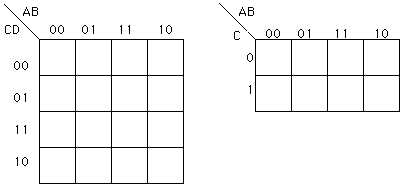
You have been learning boolean algebra and Karnaugh Maps in the class. To acheive "Two-Level Minimum Cost Designs", Simplified SOP Form or Simplified POS Form should be obtained by using Karnaugh Map Reduction. With these knowledge we have all the tools for combinational design. The steps taken for a combinational design are as follows:
- Define/describe/state the problem
- Determine the number of variables needed and assign letter symbols to the input and output variables
- Construct the function table that defines the relationship between the inputs and outputs
- Simplify the boolean expression for each output. This is done with Karnaugh Maps or Boolean algebra.
- Draw the logic diagram and implement the test circuit

The maps above are organized so that groups like AB + AB' can be recognized and reduced (to A in this case) visually. To do this the truth table is mapped into the Karnaugh map and then squares of '1's are circled from the biggest square to the smallest square. It is important that the minimum number of circles is used and that the biggest possible squares is used in order to achieve a minimum reduction. When identifying squares, it must be kept in mind that the maps are actually three dimensional as shown below:

Example of using Karnaugh map:
The truth table on the right has been mapped into the KMap
and then the squares of '1 's circled. Notice that the number
of '1's in a square is always a power of 2.

Writing out the term for each group yields the expression below:
F = A'BC'D + AC + B'D'
Note:
Any square marked by '1' can be selected more than once, but at least once.
If there are 2^k squares adjacent together, then k variables should be
eliminated.